The Intel Broadwell Review Part 2: Overclocking, IPC and Generational Analysis
by Ian Cutress on August 3, 2015 8:00 AM ESTGaming Benchmarks: High End
At the top of the line we take the best GPUs on the market from May 2015 - an AMD R9 290X and an NVIDIA GTX 980.
Alien: Isolation
If first person survival mixed with horror is your sort of thing, then Alien: Isolation, based off of the Alien franchise, should be an interesting title. Developed by The Creative Assembly and released in October 2014, Alien: Isolation has won numerous awards from Game Of The Year to several top 10s/25s and Best Horror titles, ratcheting up over a million sales by February 2015. Alien: Isolation uses a custom built engine which includes dynamic sound effects and should be fully multi-core enabled.
For low end graphics, we test at 720p with Ultra settings, whereas for mid and high range graphics we bump this up to 1080p, taking the average frame rate as our marker with a scripted version of the built-in benchmark.
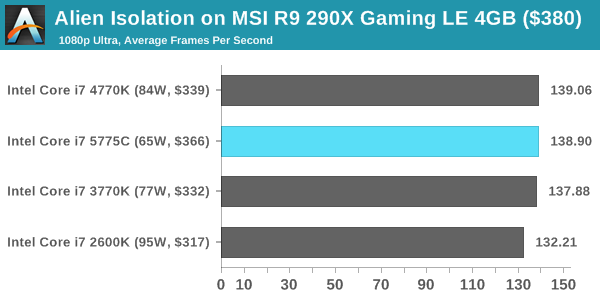
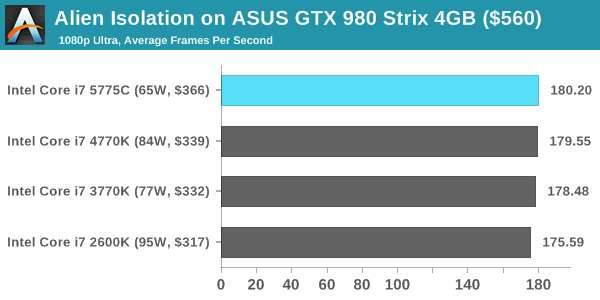
Total War: Attila
The Total War franchise moves on to Attila, another The Creative Assembly development, and is a stand-alone strategy title set in 395AD where the main story line lets the gamer take control of the leader of the Huns in order to conquer parts of the world. Graphically the game can render hundreds/thousands of units on screen at once, all with their individual actions and can put some of the big cards to task.
For low end graphics, we test at 720p with performance settings, recording the average frame rate. With mid and high range graphics, we test at 1080p with the quality setting. In both circumstances, unlimited video memory is enabled and the in-game scripted benchmark is used.
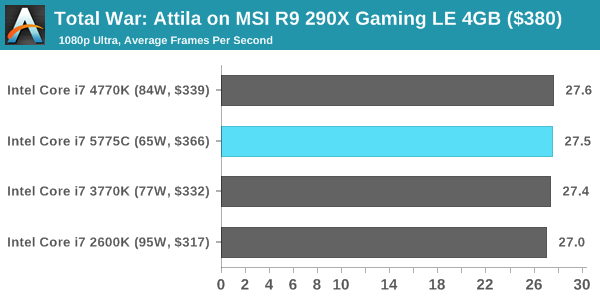

Grand Theft Auto V
The highly anticipated iteration of the Grand Theft Auto franchise finally hit the shelves on April 14th 2015, with both AMD and NVIDIA in tow to help optimize the title. GTA doesn’t provide graphical presets, but opens up the options to users and extends the boundaries by pushing even the hardest systems to the limit using Rockstar’s Advanced Game Engine. Whether the user is flying high in the mountains with long draw distances or dealing with assorted trash in the city, when cranked up to maximum it creates stunning visuals but hard work for both the CPU and the GPU.
For our test we have scripted a version of the in-game benchmark, relying only on the final part which combines a flight scene along with an in-city drive-by followed by a tanker explosion. For low end systems we test at 720p on the lowest settings, whereas mid and high end graphics play at 1080p with very high settings across the board. We record both the average frame rate and the percentage of frames under 60 FPS (16.6ms).
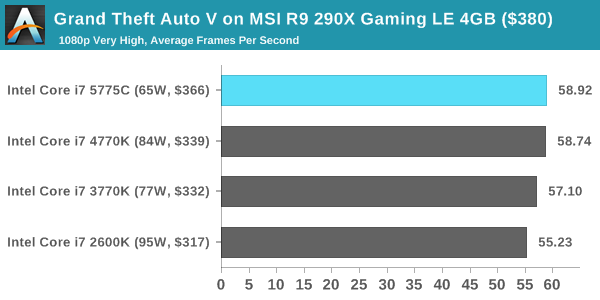
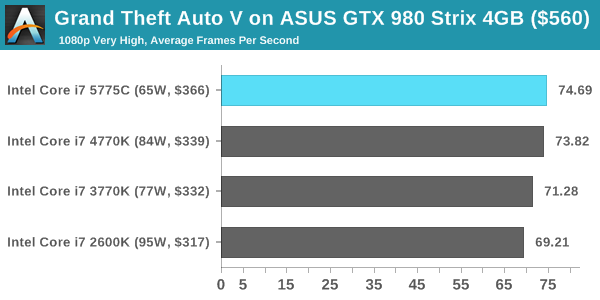
GRID: Autosport
No graphics tests are complete without some input from Codemasters and the EGO engine, which means for this round of testing we point towards GRID: Autosport, the next iteration in the GRID and racing genre. As with our previous racing testing, each update to the engine aims to add in effects, reflections, detail and realism, with Codemasters making ‘authenticity’ a main focal point for this version.
GRID’s benchmark mode is very flexible, and as a result we created a test race using a shortened version of the Red Bull Ring with twelve cars doing two laps. The car is focus starts last and is quite fast, but usually finishes second or third. For low end graphics we test at 1080p medium settings, whereas mid and high end graphics get the full 1080p maximum. Both the average and minimum frame rates are recorded.
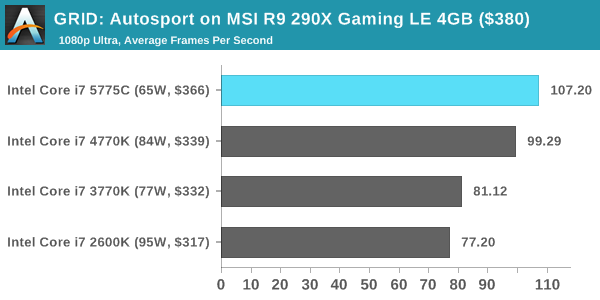
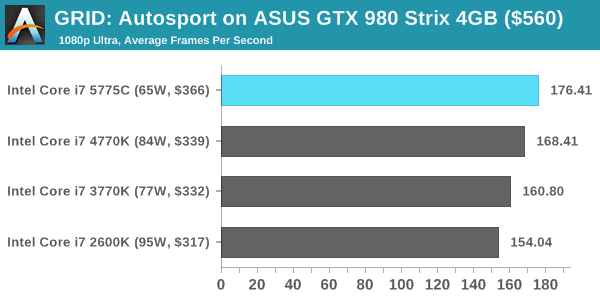
Middle-Earth: Shadows of Mordor
The final title in our testing is another battle of system performance with the open world action-adventure title, Shadows of Mordor. Produced by Monolith using the LithTech Jupiter EX engine and numerous detail add-ons, SoM goes for detail and complexity to a large extent, despite having to be cut down from the original plans. The main story itself was written by the same writer as Red Dead Redemption, and it received Zero Punctuation’s Game of The Year in 2014.
For testing purposes, SoM gives a dynamic screen resolution setting, allowing us to render at high resolutions that are then scaled down to the monitor. As a result, we get several tests using the in-game benchmark. For low end graphics we examine at 720p with low settings, whereas mid and high end graphics get 1080p Ultra. The top graphics test is also redone at 3840x2160, also with Ultra settings, and we also test two cards at 4K where possible.
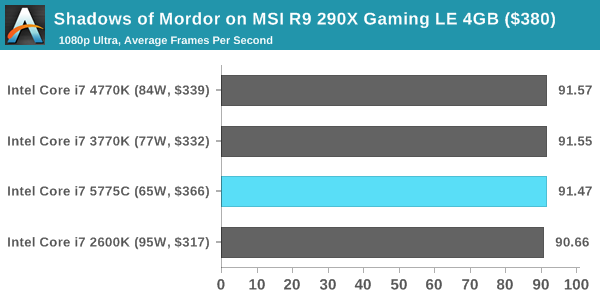
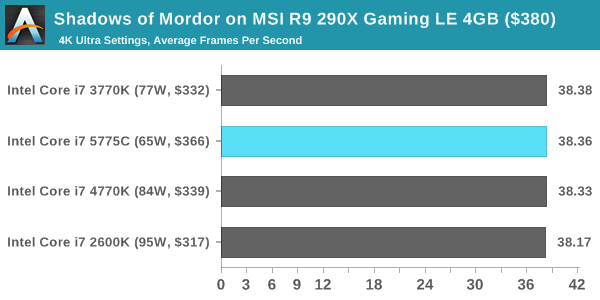
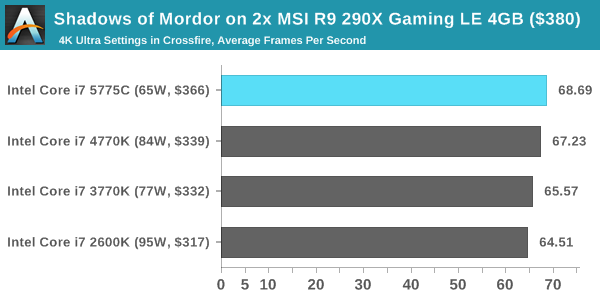
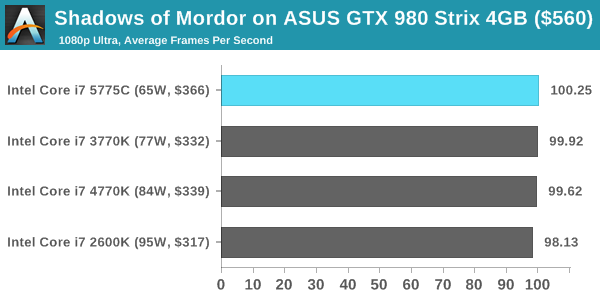
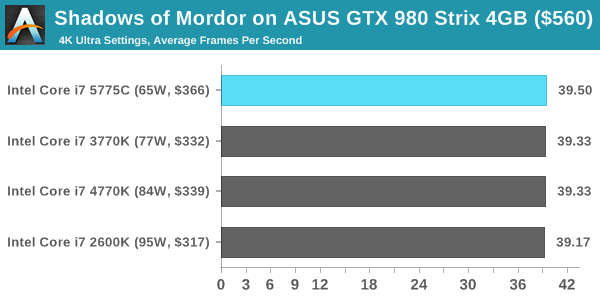
















121 Comments
View All Comments
Shadowmaster625 - Monday, August 3, 2015 - link
I never understood the "pea size" method. Peas come in many different sizes. And it seems to me that the size of a typical pea is rather large. You need something standard, like a bb. They are a standard size, 0.177 caliber, and three of them in a line seems to work best.Pissedoffyouth - Monday, August 3, 2015 - link
I put a grain of rice size in the middle. get a glasses cloth and rub it on both the heatsink and the heat spreader, and rub it off. Should be a slight tinting left.Then put another grain of rice size in the middle and screw the heatsink in. Done.
You want to use the bare minimum amount of paste.
zodiacfml - Monday, August 3, 2015 - link
Very polarizing CPU. Any ideas why Intel doesn't have Crystalwell in laptops? I don't want a discrete GPU anymore in mobile due to risk of dead GPUs/Mobo after a few years.zodiacfml - Monday, August 3, 2015 - link
Oh, nevermind! I found them.extide - Monday, August 3, 2015 - link
They do, but the CPU's with Crystalwell are quite expensive, so most OEM's shy away from them because it is too expensive for a cheap laptop, and then a higher end laptop they put a dGPU in.In my next laptop, I want a Iris Pro (w/ Crystalwell) chip, and NO DGPU! I don't want the power consumption, and Iris Pro is plenty enough performance for what I do on a laptop. Unfortunately, it's kinda hard to find high-ish end laptop's with that config. :(
Gigaplex - Monday, August 3, 2015 - link
Before Broadwell, the only way to get Crystalwell was in the mobile chips.varg14 - Monday, August 3, 2015 - link
Until my pretty much 5 year old Sandy Bridge 2600k that runs between 4.5-5.0ghz PCIE 2.0 @ 8x lane speed does not bottleneck a dual GPU setup to the point it can not push at least 60FPS at 3440-1440 resolution on my 34" 21/9 LG 34UM95 monitor their is no reason to upgrade whatsoever.Also with DX12's reduced CPU overhead any new DX12 games should run great with a old Sandy CPU. Also DX12 Should greatly improve the performance of my EVGA's GTX 770 4gb Classified SLI setup since it will split frame render instead of alternate frame rendering allowing the vram to be sorta stacked since each card is only rendering half a frame instead of a whole frame allowing the 4gb of Vram on each card to act like one 8GB card.
PrinceGaz - Monday, August 3, 2015 - link
Skylake should be the big one that has been waited for since Sandy Bridge; Ivy Bridge's tick reduced overclockability because of the process node, Haswell improved IPC but added the onboard voltage regulator which made overclocking at that node still worse, and Broadwell keeps the voltage regulator whilst further focussing on lower power.I'm not saying Skylake will go to the dizzying raw gigahertz of Sandy Bridge, but two generations of tocks, and the removal of the onboard voltage regulator, and if we're lucky, the improved thermal compound used in Haswell Devil's Canyon, could together make for a significantly faster chip; one which may well see the upper ends of the 4.x GHz attainable.
Impulses - Monday, August 3, 2015 - link
Fingers crossed, if it can come near SB levels of OC I'd be complacent... Just enough for the IPC advantage not to be mitigated by raw clock speed, I'm really upgrading my 2500K for the platform anyway (M.2 in particular) but it'd be nice to get a halfway decent CPU upgrade.Aspiring Techie - Monday, August 3, 2015 - link
The Broadwell equivalent of a Sandy Bridge 5.0 GHz overclock in raw instruction throughput (assuming that Skylake doesn't have any improvement in ipc) is 4.3 GHz. A 4.6 GHz Haswell overclock is equivalent to a 4.4 GHz Broadwell. Broadwell wasn't designed for the desktop, so it isn't designed for good overclocking. If Skylake's consumer flagship has the same clocks as the 4790K with say 10% ipc over Broadwell, then at 4.4 GHz, it has will have the same instruction throughput as a 5.0 GHz Haswell or a 5.7 GHz Sandy Bridge chip. The overclock should increase as the 14nm process becomes more mature, so less voltage is needed for better clocks. If Intel does it right, then everyone will be happy (except AMD since Zen would be screwed over).